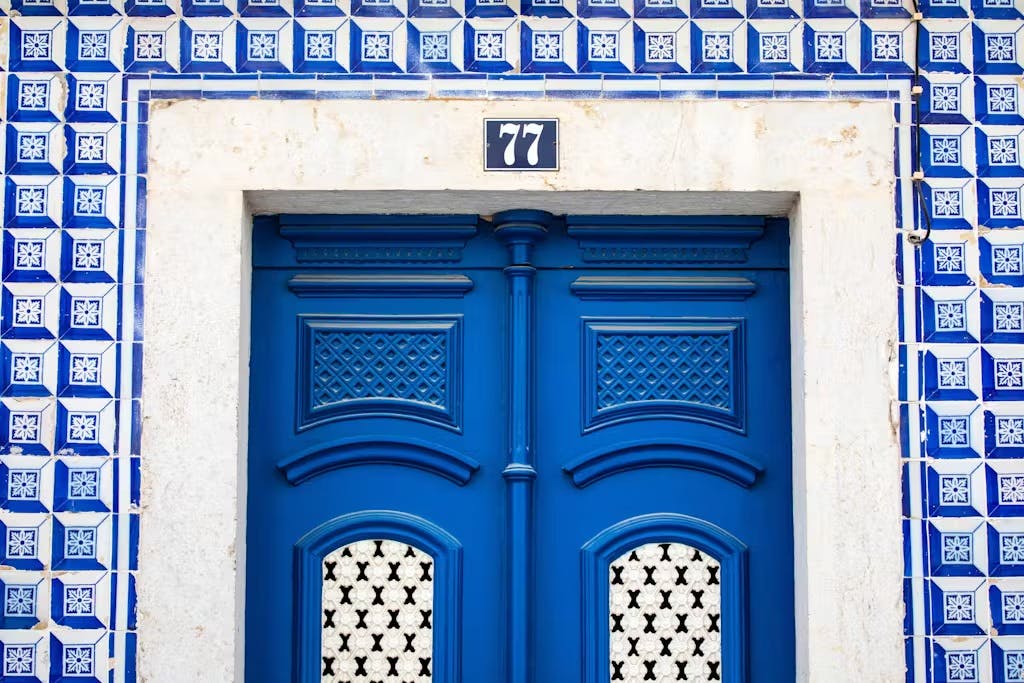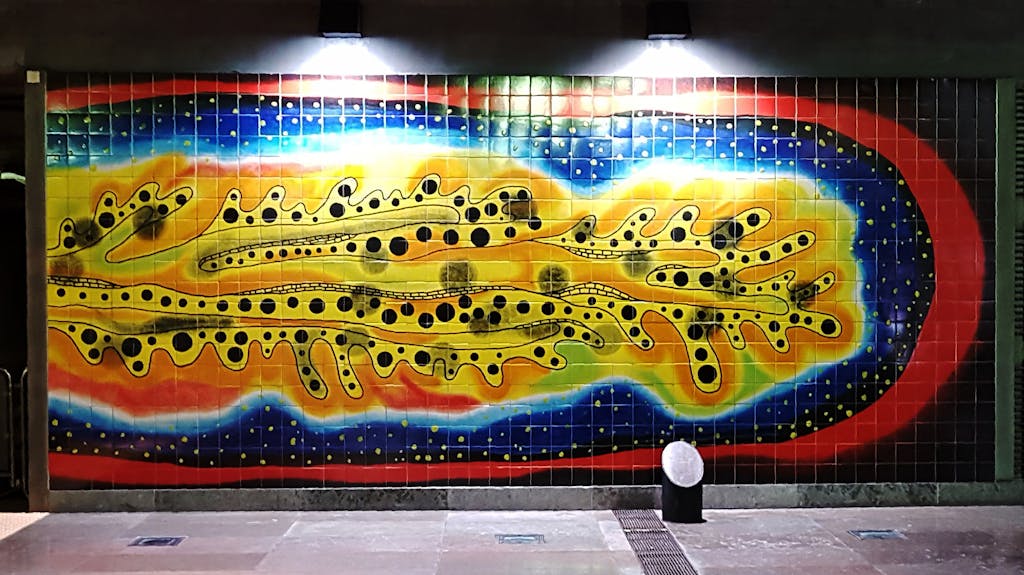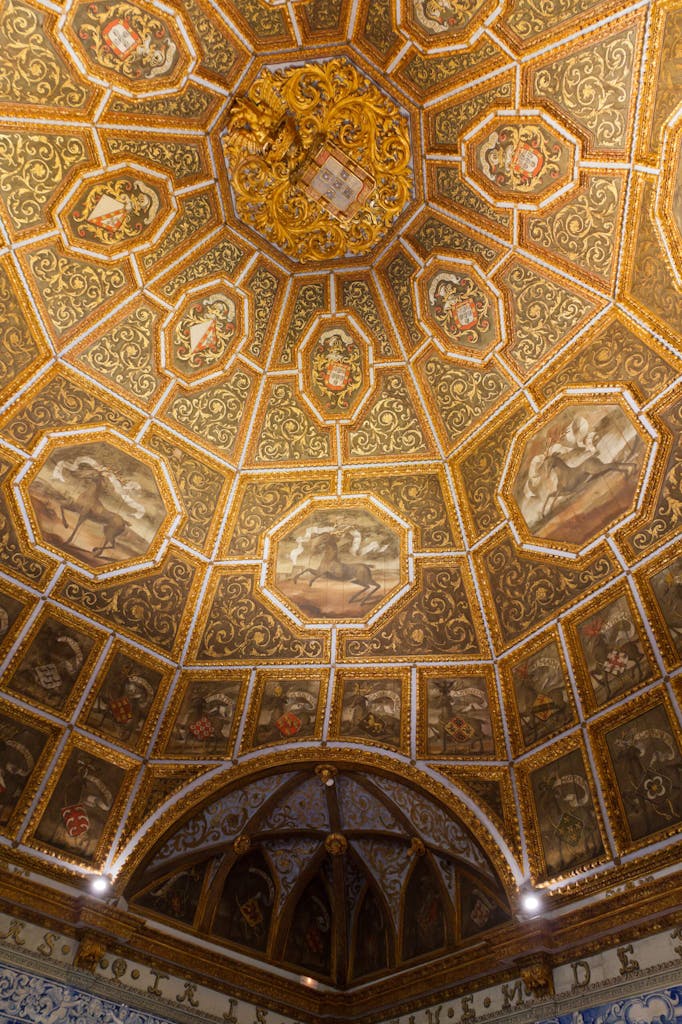What to Do in Lisbon: Portugal’s Azulejos Beautifully Reveal History and Culture
They are in palaces, churches, train stations, houses and more. Those glazed ceramic tiles called azulejos are seemingly everywhere in Portugal. Anyone wondering what to do in Lisbon can make spotting — and photographing them — a joyful pursuit.
Often covering entire walls, ceilings and floors, even the facades of houses, azulejos can be found in large murals made up of many individual (and sometimes thousands of) tiles that resemble paintings. This cultural treasure has evolved into a distinctly Portuguese art form that continues today as artists experiment with and reinvigorate the beloved craft.
Arabs from North Africa brought the craft of glazed tiles to Portugal in the 13th century. Portugal fell in love with the Moorish penchant for adorning walls and ceilings with the colorful glazed tiles. An enduring love affair began to reflect different design styles as varied as Hispano-Moorish — mostly geometric and floral motifs because Islam forbade representing the human figure in art — and Renaissance, Baroque, Neoclassical, Art Nouveau and modernist.
The story behind azulejos

The best-known styles, cobalt blue designs on white backgrounds depicting people in historical, religious, mythological and everyday scenes or landscapes, or a palette of blue, yellow and white flourished during the 17th and 18th centuries, the Golden Age of azulejos.
“Portuguese tiles are different from tiles in Spain or Morocco in terms of their design, history and production techniques,” says Jayme Simoes, a spokesman for the Visit Alentejo region in south-central Portugal.
“Spanish tiles, in contrast, often have more vivid colors, like red, green and yellow, and may be patterns inspired by Islamic art. Moroccan tiles have geometric patterns and calligraphy in vibrant colors.”
Typically, azulejos are made with a tin-glazed technique called majolica, in which a white glaze is applied to tiles and the design is painted on top. Spanish tiles often have raised lines between glazes, created by a wax-resistant method, and Moroccan tiles are often made by cutting geometric shapes from clay tiles and fitting them together like a puzzle.
In Lisbon (a panoramic view of the historic city is pictured at the top of this story), the Museo Nacional do Azulejo, housed in a 1509 convent, displays superb examples from different eras. The panorama of Lisbon and its coast, composed of more than 1,300 tiles, shows the city before the devastating 1755 earthquake.

It’s fun picking out landmarks that survive. Those include the Tower of Belem — a 16th-century stone fortification where Portuguese explorers departed for the New World — as well as the Castle of St. George crowning a hill in the historic Alfama district.
You’ll also see “The Chicken’s Wedding,” a whimsical multicolored tile mural of a chicken riding a coach driven by a costumed monkey, and a multicolored tile mural of a hunting scene in which leopards are pursued by hunters armed with bows and arrows.
Blue-and-white tile panels illustrate stories from the Bible and about saints in the ornately gilded Baroque Madre de Deus church and cloisters.

Inside Lisbon’s Palacio de Fronteira, a 17th-century palace in the Benfica suburb, tiles depict eight battles from the War of Restoration of 1640-68, which ended Portugal’s union with Spain. In the gardens, tile panels show female figures who represented poetry, music, astronomy and other arts and sciences of the classical world.
A modern look at the craft

To see a contemporary spin, ride the Lisbon Metro, where subway stations are beautified with azulejos. Oriente Station, a lacy glass-and-steel architectural marvel designed by Santiago Calatrava, features a variety of ocean-themed tile murals from 10 international artists. You’ll also find geometric and abstract tile murals by Portuguese artist Maria Keil in the Parque and Restauradores stations, among others
You will see Lisbon’s biggest azulejo mural, a 11,625-square-foot artwork composed of more than 52,700 tiles, at Jardim Botto Machado, created in 2016 by graffiti artist André Saraiva. The garden’s mural features imaginary cityscapes of Lisbon, New York, Paris and Los Angeles, cities important in his life.
All tiles were made at the Viuva Lamego, the now-closed factory in Lisbon’s Mouraria district, whose façade depicts tile murals of Asian men in conical-shaped hats and vases of flowers, in homage to Portugal’s trade with Asia and its former colonies there.
Like a fairy tale

Sintra, a fairytale-like town of palaces, villas and parks in hills surrounded by forests, is a 40-minute train ride north of Lisbon. In this UNESCO town’s Palacio Nacional, you’ll find a frieze of Moorish-style azulejos in starburst patterns in bold black, blue and orange, circa 1520.

In Palacio de Pena, the yellow and red Romanticist palace that fuses Moorish, Egyptian, Gothic and Renaissance styles, Moorish-style geometric-patterned tiles in gray, yellow, white and gilt adorn the queen’s bedroom ceiling. Swan azulejos decorate the Swan Room ceiling.

In the Palacio Nacional de Queluz, an 18th-century palace midway between Lisbon and Sintra known as Portugal’s Versailles, the continents, the seasons, hunting, scenes from classical mythology and a Chinese pagoda beautify tile panels. Outdoors, Tiled Canal is intricately embellished with lavender, yellow and dark and light blue.

In Évora, a magnificent walled city and UNESCO site less than two hours east of Lisbon by train, Biblical scenes, such as Jesus teaching in the temple, can be seen in the Church of the Misericordia. This former Roman colony and capital of the Alentejo, a rural region of cork and olive trees and wheat fields, also has 18th-century blue-and-white tile murals of Plato and his disciples and Aristotle teaching Alexander the Great in its Old University.
The Museu Berardo Estremoz, Portugal’s biggest tile collection, is a 40-minute drive or bus east of Évora. It showcases 800 years of tiles from the collection of José Berardo, a businessman and art collector, most from Portugal but also from other European countries.
In Porto, the country’s second-largest city, the São Bento railway station is a major draw (and not just because the train to Lisbon is less than three hours away). Huge murals made up of more than 20,000 tiles depict historic and rural scenes, and early forms of transportation adorn the 1916 station.
The stone façade of Porto’s Church of St. Ildefonso, built in 1739, is adorned with more than 11,000 blue and white tiles, added by Jorge Colaco, the same artist whose work appears at the train station.
All of this and more is available to enjoy on your next cruise to Portugal. Beyond exploring what to do in Lisbon, you can delve into the history of the azulejos all around the country, each tile adding to this rich, colorful and uniquely Portuguese story.
Is a visit to Portugal high on your list? Many Mediterranean sailings can take you there.
